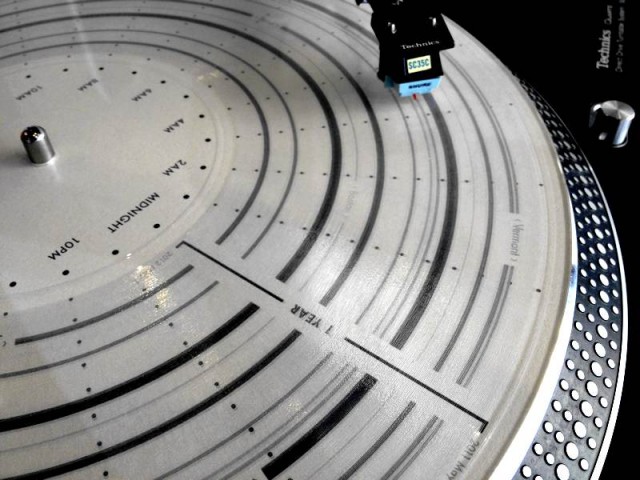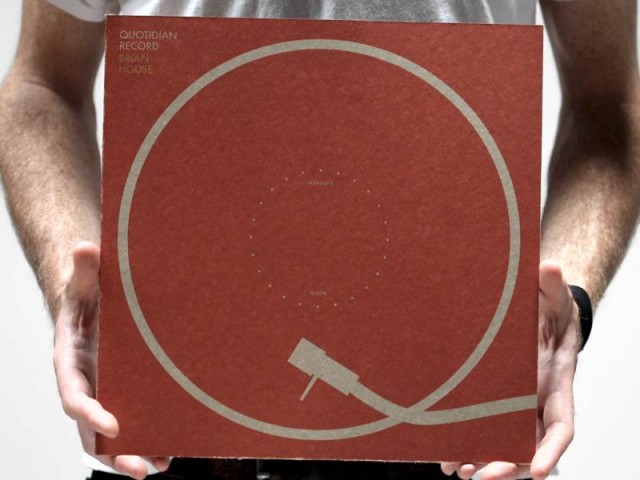We have data in pictures, we have data in Facebook posts – why not data as music?
In the latest data sonification project, the record of travel becomes an oddly-beautiful set of percussive harmonies. And it’s a “record” in every sense: artist and composer Brian House not only composes the data into pleasing sonorities, but presses them into a rather elegant limited-edition vinyl.
And the whole project is powered by our very own open source MeeBlip synthesizer, demonstrating that you can coax a range of sounds out of traditional 2-oscillator subtractive synthesis.
With that unique take on what happens on vinyl, it’s a fitting companion to last week’s “new ideas for turntables”:
Fun with Turntables: Liberating the Decks By Dancing, Loading Hacks as Records
And, incidentally, all of this says that the battle between vinyl naysayers and turntable purists is as silly as ever: there’s no end of new ideas for rethinking the record.
One could see this as just artistic oddity, but as more and more artists take on these kind of tasks, there’s a political angle, too. Personal data is increasingly locked up in private stores, government and corporate surveillance. Whatever your take on the value of that – and I’m certainly one to trade a lot of privacy for goodies in return in my own life – surely there’s some equal value in amassing some data yourself. In this case, working with New York’s Eyebeam research center (among other partners), and the open source OpenPaths system Mr. House developed with researchers at The New York Times, data is personal. And, as you’ll hear, musical, too.
Given that there’s this platform with which to work, in fact, I wonder if there wouldn’t be some value in getting more musicians composing with data. I’d love to hear other attempts at making sonorous sense of the numbers – whether only aesthetic, or truly illuminating in nature. Anyone who might be up for helping organize such a thing, let us know.
In the meantime, here’s more on the work:
Quotidian Record is a limited edition vinyl recording that features a continuous year of my location-tracking data. Each place I visited, from home to work, from a friend’s apartment to a foreign city, is mapped to a harmonic relationship. 1 day is 1 rotation … 365 days is ~11 minutes.
As the record turns, the markings on the platter indicate the rotational cycle through 24 hours and the key changes that occur when I travel to cities in which I do not live. The sound suggests that our habitual patterns have inherent musical qualities, and that daily rhythms might form an emergent portrait of an individual.
Edition of ten.
Concept, data performance, programming, and audio Brian House
Design and production Greg Mihalko
Vinyl production Ted Reiderer / Never Records
Mastering Nik Levinsky
Data gathered via OpenPaths
Supported by Eyebeam Art & and Technology Center
Thanks: The New York Times Research and Development Lab
http://brianhouse.net/works/quotidian_record/
As seen, quite some time ago, by those eagle-eyed tech follower friends of ours at The Verge (so far as I’m concerned, the best general tech blog around)
Updated: Brian adds some more comments on how the sonification works.
Your readers might want to know that what you’re hearing on the record is all MeeBlip — I have two of them. the code is all written in Python, it finds clusters of significant locations from the lat/lon data and assigns harmonies to them (the key changes when the city changes). everything is quantized to a pulse that maps to two hours, and rapid location changes are distributed with a space-filling algorithm so that they are legible. the Python script then spits out MIDI in realtime, over two channels, to the MeeBlips, which I am then running through an assortment of stompboxes that I had lying around.
I’m sending the result back into the box, but there is very little post processing. The MeeBlips are my first experience with synths, and they have been great, thanks for that.

